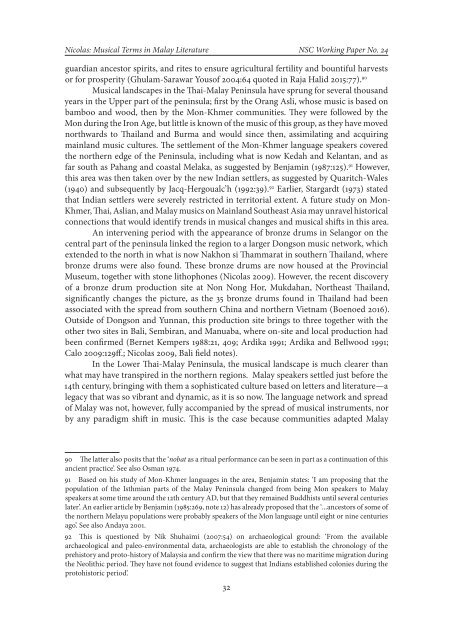2k2ADzp
2k2ADzp
2k2ADzp
Create successful ePaper yourself
Turn your PDF publications into a flip-book with our unique Google optimized e-Paper software.
Nicolas: Musical Terms in Malay Literature NSC Working Paper No. 24<br />
guardian ancestor spirits, and rites to ensure agricultural fertility and bountiful harvests<br />
or for prosperity (Ghulam-Sarawar Yousof 2004:64 quoted in Raja Halid 2015:77). 90<br />
Musical landscapes in the Thai-Malay Peninsula have sprung for several thousand<br />
years in the Upper part of the peninsula; first by the Orang Asli, whose music is based on<br />
bamboo and wood, then by the Mon-Khmer communities. They were followed by the<br />
Mon during the Iron Age, but little is known of the music of this group, as they have moved<br />
northwards to Thailand and Burma and would since then, assimilating and acquiring<br />
mainland music cultures. The settlement of the Mon-Khmer language speakers covered<br />
the northern edge of the Peninsula, including what is now Kedah and Kelantan, and as<br />
far south as Pahang and coastal Melaka, as suggested by Benjamin (1987:125). 91 However,<br />
this area was then taken over by the new Indian settlers, as suggested by Quaritch-Wales<br />
(1940) and subsequently by Jacq-Hergoualc’h (1992:39). 92 Earlier, Stargardt (1973) stated<br />
that Indian settlers were severely restricted in territorial extent. A future study on Mon-<br />
Khmer, Thai, Aslian, and Malay musics on Mainland Southeast Asia may unravel historical<br />
connections that would identify trends in musical changes and musical shits in this area.<br />
An intervening period with the appearance of bronze drums in Selangor on the<br />
central part of the peninsula linked the region to a larger Dongson music network, which<br />
extended to the north in what is now Nakhon si Thammarat in southern Thailand, where<br />
bronze drums were also found. These bronze drums are now housed at the Provincial<br />
Museum, together with stone lithophones (Nicolas 2009). However, the recent discovery<br />
of a bronze drum production site at Non Nong Hor, Mukdahan, Northeast Thailand,<br />
significantly changes the picture, as the 35 bronze drums found in Thailand had been<br />
associated with the spread from southern China and northern Vietnam (Boenoed 2016).<br />
Outside of Dongson and Yunnan, this production site brings to three together with the<br />
other two sites in Bali, Sembiran, and Manuaba, where on-site and local production had<br />
been confirmed (Bernet Kempers 1988:21, 409; Ardika 1991; Ardika and Bellwood 1991;<br />
Calo 2009:129ff.; Nicolas 2009, Bali field notes).<br />
In the Lower Thai-Malay Peninsula, the musical landscape is much clearer than<br />
what may have transpired in the northern regions. Malay speakers settled just before the<br />
14th century, bringing with them a sophisticated culture based on letters and literature—a<br />
legacy that was so vibrant and dynamic, as it is so now. The language network and spread<br />
of Malay was not, however, fully accompanied by the spread of musical instruments, nor<br />
by any paradigm shit in music. This is the case because communities adapted Malay<br />
90 The latter also posits that the ‘nobat as a ritual performance can be seen in part as a continuation of this<br />
ancient practice’. See also Osman 1974.<br />
91 Based on his study of Mon-Khmer languages in the area, Benjamin states: ‘I am proposing that the<br />
population of the Isthmian parts of the Malay Peninsula changed from being Mon speakers to Malay<br />
speakers at some time around the 12th century AD, but that they remained Buddhists until several centuries<br />
later’. An earlier article by Benjamin (1985:269, note 12) has already proposed that the ‘...ancestors of some of<br />
the northern Melayu populations were probably speakers of the Mon language until eight or nine centuries<br />
ago’. See also Andaya 2001.<br />
92 This is questioned by Nik Shuhaimi (2007:54) on archaeological ground: ‘From the available<br />
archaeological and paleo-environmental data, archaeologists are able to establish the chronology of the<br />
prehistory and proto-history of Malaysia and confirm the view that there was no maritime migration during<br />
the Neolithic period. They have not found evidence to suggest that Indians established colonies during the<br />
protohistoric period’.<br />
32


